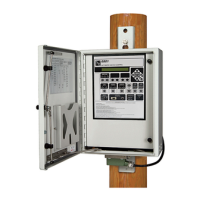Switch Control Setup
Phase Current Inrush Restraint Time (Milliseconds)
Set this setpoint to a value long enough to allow the inrush/load pickup current to drop
below the Phase Fault Detection Current Level setpoint before the timer expires.
(Range: 0.00-1,593.75; Step: 6.25; Default: 75.00)
Phase Current Inrush Restraint Multiplier
Select either the Time Block or a Multiplier Value setting. Either setting is used only
for the duration of the Phase Current Inrush Restraint Timer setpoint. Time Block
is the default setting.
Time Block—Phase overcurrents are not qualied until the restraint timer expires. If
an overcurrent condition is present at the end of the time block, the switch control starts
the Phase Fault Duration Time Threshold timer. Adjust the Phase Fault Duration
Time Threshold and Phase Current Inrush Restraint Time setpoints to ensure the
switch control has enough time after the time block to detect a phase fault before the
feeder breaker operates again.
Multiplier Value—The Phase Fault Detection Current Level setting is temporarily
raised by the selected multiplier value: 2x, 4x, 8x, or 16x. If the switch control detects
current magnitudes greater than the elevated level, it starts the Phase Fault Duration
Time Threshold timer. The switch control records a fault when the current remains
above fault levels and the timer expires.
Where possible, set the multiplier to raise the Phase Fault Detection Current Level
setting above the expected inrush/load pickup levels but below end-of-line minimum
phase-fault current levels. The end-of-line minimum phase-fault levels may be estimated
as 60% of end-of-line maximum fault current levels where the end-of-line levels are defined
as the worst case end-of-line level after load has been transferred to the alternate feed.
When the inrush multiplier raises the elevated fault detection current level to a value that
exceeds actual fault current, the result is the same as selecting the Time Block setting.
Check that there is enough time after the phase-inrush restraint timer expires to
detect a fault. Consider fault-current values up to the Phase Fault Detection Current
Level setting.
For example, when the Phase Fault Detection Current Level setting is 860 and
the Phase Current Inrush Restraint Multiplier setting is set to 4x, during the Phase
Current Inrush Restraint Time period, the switch control ignores all phase-fault condi-
tions of less than 3440 RMS amps. The switch control responds to all faults of at least
860 amps when the inrush restraint time expires.
Note: Actual fault duration may be longer than the duration reported in the historic
log. When the Phase Current Inrush Restraint Multiplier or the Ground Current
Inrush Restraint Multiplier feature is set to the Time Block mode:
• The control does not count the portion of the fault occurring in the Time Block period.
• The Fault Duration Time Threshold timer begins counting when the Time Block
ends.
• Actual fault duration may be longer than the duration reported in the historic log.
• Faults that do not qualify are disregarded.
Ground Current Inrush Restraint Time (Milliseconds)
Estimate the maximum imbalance inrush/load pickup current and its duration at the
switch. Set this setpoint to a value long enough to allow the inrush/load pickup current
to drop below the Ground Fault Detection Current Level setpoint before the timer
expires. (Range: 0-999,950; Step: 50; Default: 100)
Ground Current Inrush Restraint Multiplier
Select either the Time Block or Multiplier Value setting. Either setting is used only
for the duration of the Ground Current Inrush Restraint Timer period. Time Block is
the default setting.
S&C Instruction Sheet 1045-530 35

